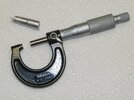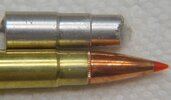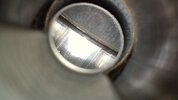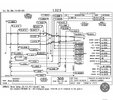I trim my cases to the recommended length of 10 thousand less than max SAMMI specs. I came across and watched this video that suggested that you can eliminate or reduce the carbon ring by measuring the chamber length and only trimming off 5 thousand from that length. Has anyone done this? If so, does it work? Is it better to just follow SAMMI specs and keep your gun clean? Thoughts. I'm getting ready to retire an old lot of Winchester .308 brass and bring in a new lot.
 www.bing.com
www.bing.com
You are using an out of date browser. It may not display this or other websites correctly.
You should upgrade or use an alternative browser.
You should upgrade or use an alternative browser.
Trimming Cases and the Carbon Ring
- Thread starter emb
- Start date
AJC1
Member
You will only move the location of the deposits. Proper cleaning is the only regimine to manage the fowling.I trim my cases to the recommended length of 10 thousand less than max SAMMI specs. I came across and watched this video that suggested that you can eliminate or reduce the carbon ring by measuring the chamber length and only trimming off 5 thousand from that length. Has anyone done this? If so, does it work? Is it better to just follow SAMMI specs and keep your gun clean? Thoughts. I'm getting ready to retire an old lot of Winchester .308 brass and bring in a new lot.
trimming cases and carbon ring - Search Videos
www.bing.com
Varminterror
Member
- Joined
- Jul 17, 2016
- Messages
- 15,123
There are ways to make your own gauges, but Sinclair offers Chamber Neck Arbors which reloaders can use to detect the end of the neck in their chambers. It IS better to ignore SAAMI specs and trim your brass to match your actual chamber.

Yes, trimming your brass to offer minimal clearance at the chamber neck can help reduce carbon ring. It also increases your sensitivity to carbon ring because the brass elbow room has less room as it swells and stretches.
Easier, just clean your chamber necks every few hundred rounds, or dip a bore-scope to identify when you start having a ring and need to clean, AND then dip again to confirm you do not have a carbon ring remaining after cleaning.
I have a few calibers of the Sinclair plugs kicking around in a box somewhere, but more often, I have made my own gauges by cutting a case neck and seating a flat based bullet upside down (some folks use epoxy to secure the ring to the bullet). Seat the upside down bullet long in a short cut case, pull your ejector from your bolt, hook the modified case into the extractor, then use the chamber to dead-length the bullet down into the case. Measure the result, subtract 5-10thou, and trim to that length.

Yes, trimming your brass to offer minimal clearance at the chamber neck can help reduce carbon ring. It also increases your sensitivity to carbon ring because the brass elbow room has less room as it swells and stretches.
Easier, just clean your chamber necks every few hundred rounds, or dip a bore-scope to identify when you start having a ring and need to clean, AND then dip again to confirm you do not have a carbon ring remaining after cleaning.
I have a few calibers of the Sinclair plugs kicking around in a box somewhere, but more often, I have made my own gauges by cutting a case neck and seating a flat based bullet upside down (some folks use epoxy to secure the ring to the bullet). Seat the upside down bullet long in a short cut case, pull your ejector from your bolt, hook the modified case into the extractor, then use the chamber to dead-length the bullet down into the case. Measure the result, subtract 5-10thou, and trim to that length.
Varminterror
Member
- Joined
- Jul 17, 2016
- Messages
- 15,123
You will only move the location of the deposits.
Carbon ring deposits form between the end of the case neck and the end of the chamber neck. More room due to excessive case trimming (under-length case necks) means more room for more deposits. It doesn't really change location, it just gets longer or shorter.
Varminterror
Member
- Joined
- Jul 17, 2016
- Messages
- 15,123
Those were some of my thoughts too. I thought that less room may make the impingement issue worse rather than better.
The more room we have, the more opportunity for eddy diffusion and more opportunity for deposition.
A good example is a revolver barrel/cylinder gap - with a tight gap, there is too much resistance to flow out of the gap, so more pressure and more flow is retained in the bore. With a wider gap, flow fields are more readily established through the B/C gap, and we get more gap flash, more fouling on the cylinder face, more velocity loss, etc. If the flow can't fit, it don't go, so smaller gaps mean less fouling... Until the fouling gets there, then there's less room for it, and we spike a little faster. So it takes longer to become a problem, but it's more suddenly a problem when it becomes one.
FROGO207
Member
Sometimes the simplest way is the best path. We all want to make things easier but more steps just add time to something that's not needed or worth it for most of us.
Varminterror
Member
- Joined
- Jul 17, 2016
- Messages
- 15,123
Eh, to each their own.
Some people screw their sizing die down to touch the shellholder, plus 1/2 turn deeper, and smile as they make undersized brass for their rifle. Some set their seating dies to seat bullets at whatever the book says for COAL, and they smile as they fire unknown jump to lands. Some folks trim their cases to 10 thou under SAAMI maximum case length (SAAMI does not publish a trim length - they publish a max length and a maximum underlength tolerance for case length) and smile as they cut cases far too short for their chambers and leave large harbors for carbon rings to develop.
Some people set their sizing die by measuring their actual rifle chambers and sizing brass to match a specific shoulder bump. Some people set their seating dies to deliver a specific bullet jump to lands in their actual rifle chambers. Some people set their trim length minimize the clearance at the mouth of the case to reduce or eliminate the opportunity for carbon ring deposition.
Neither is really the wrong method as long as the people pursuing each are content with the results they find from their loads in their applications.
Some people screw their sizing die down to touch the shellholder, plus 1/2 turn deeper, and smile as they make undersized brass for their rifle. Some set their seating dies to seat bullets at whatever the book says for COAL, and they smile as they fire unknown jump to lands. Some folks trim their cases to 10 thou under SAAMI maximum case length (SAAMI does not publish a trim length - they publish a max length and a maximum underlength tolerance for case length) and smile as they cut cases far too short for their chambers and leave large harbors for carbon rings to develop.
Some people set their sizing die by measuring their actual rifle chambers and sizing brass to match a specific shoulder bump. Some people set their seating dies to deliver a specific bullet jump to lands in their actual rifle chambers. Some people set their trim length minimize the clearance at the mouth of the case to reduce or eliminate the opportunity for carbon ring deposition.
Neither is really the wrong method as long as the people pursuing each are content with the results they find from their loads in their applications.
rdnktrkr
Member
I can see some of the benefits of knowing your chamber measurements, What are the best ways to create a casting of your chamber? I see "Cerrosafe" at Brownells but pouring a molten metal through my bolt action scares me. Is there something like epoxy or a liquid JB weld that is also usable?
I have a couple of tight chambers that requires certain brass to chamber easily and if I had a cast I would know its exact dimension, If I had a known cast I would be able to trim the necks to fit the chamber also. I have done the loose fitting bullet to find the rifling but that doesn't tell me anything about the neck diameter or length.
I have a couple of tight chambers that requires certain brass to chamber easily and if I had a cast I would know its exact dimension, If I had a known cast I would be able to trim the necks to fit the chamber also. I have done the loose fitting bullet to find the rifling but that doesn't tell me anything about the neck diameter or length.
FROGO207
Member
Cerrosafe melts at about 180*F and after pouring in and waiting about 20 minutes it has contracted enough to remove easily. Then wait another 20 min and it returns to as cast size for accurate measurements. Then it expands at a known rate vs time. It will not stick in your firearm if used propperly. Just read the instructions before using the product.
I can see some of the benefits of knowing your chamber measurements, What are the best ways to create a casting of your chamber? I see "Cerrosafe" at Brownells but pouring a molten metal through my bolt action scares me. Is there something like epoxy or a liquid JB weld that is also usable?
I have a couple of tight chambers that requires certain brass to chamber easily and if I had a cast I would know its exact dimension, If I had a known cast I would be able to trim the necks to fit the chamber also. I have done the loose fitting bullet to find the rifling but that doesn't tell me anything about the neck diameter or length.
I do chamber casts for any gun new to me, and make my cartridges the maximum length the chamber allows. I don't even trim .005" off the length, and in some instances where I own 4-6 rifles in the same cartridge if there's a difference in chamber lengths I make sure loaded ammo is marked for which rifle it will be fired in. I don't have any issues with carbon rings.
I can see some of the benefits of knowing your chamber measurements, What are the best ways to create a casting of your chamber? I see "Cerrosafe" at Brownells but pouring a molten metal through my bolt action scares me. Is there something like epoxy or a liquid JB weld that is also usable?
I have a couple of tight chambers that requires certain brass to chamber easily and if I had a cast I would know its exact dimension, If I had a known cast I would be able to trim the necks to fit the chamber also. I have done the loose fitting bullet to find the rifling but that doesn't tell me anything about the neck diameter or length.
You're not pouring it "through your bolt action", you simply push a tight patch into the bore an inch past the chamber, and then use a paper funnel to guide the Cerrosafe into the chamber. Cerrosafe melts at lower temps than boiling water, so I use a can set in a pot of water to melt it. An old soup can with one edge bent into a spout shape works great. One caution, be sure to fill any extractor cuts, or voids where it might spill before pouring it in! But if you did make a mess hot boiling water, or even a hair dryer will melt it and it can flow out.
lightman
Member
I trim my brass back to spec and let my cleaning routine take care of any carbon build up or fouling. But I guess I never even thought about it?
Varminterror
Member
- Joined
- Jul 17, 2016
- Messages
- 15,123
What are the best ways to create a casting of your chamber? I see "Cerrosafe" at Brownells but pouring a molten metal through my bolt action scares me. Is there something like epoxy or a liquid JB weld that is also usable?
Use Cerrosafe.
Pouring hardening and adhesive epoxy into your action should scare you more than pouring a proven product made to release itself from your chamber. Cerrosafe also melts at a RIDICULOUSLY low temp, hot enough to cause contact burns to skin, but NOT hot enough to damage even the finish of your firearm.
I can see some of the benefits of knowing your chamber measurements
Cerrosafe is how we are able to measure diameters for different aspects of our chambers. But we can use a few "dead-length" methods to determine different LENGTHS of our chambers. The Bolt Close method helps us set our sizing die (wheeleraccuracy.com/videos, scroll to "sizing brass"), then the Bolt Lift Method for setting our bullet seating die (wheeleraccuracy.com/videos, scroll to "finding your lands"), and use tools like the Sinclair Neck Gauge Arbors to set your case trimmer. A pin gauge can typically be used to determine the diameter of the neck, but for body or shoulder diameter, a cerrosafe casting is really the best tool for the task.
rdnktrkr
Member
My next Brownells order, I will add some cerrosafe, also I'll look for a mandrel die set, this year I'm wanting to stretch out my Howa 1500 and see if I can figure out what is happening past 300yrds, (currently I'm accurate at 300 but not at 600). Thanks for the responses
Varminterror
Member
- Joined
- Jul 17, 2016
- Messages
- 15,123
I guess I never even thought about it?
Most reloaders never do, but why don’t we? We have a post EVERY. SINGLE. DAY. about bullet jump, headspace tools and gauges, and COAL, and we have threads all the time about small base dies, or about bullet bases protruding below case necks and eating into powder capacity… AND we see threads about carbon rings, formation rates and round counts, how to clean them, what powders make them worse than others… but why do folks just accept a trim length in a reloading manual and never give it a second thought?
Taking a moment to think about it now:
I trim my brass back to spec
What is “spec”?
SAAMI “spec” for case length is NOT a reference dimension, and is typically defined as a maximum length and a negative tolerance. Chamber depth to the neck is a reference distance, with no tolerance listed.
Reloading manuals typically list the SAAMI max length as the “case length” and then list a trim length which is 10 thou there under… which SAAMI negative tolerance is typically 12 to 30 thou, which isn’t what we see in the reloading manuals - just 10 thou.
So what is spec? Do we KNOW our chamber is cut to exactly SAAMI reference depth? Do we think 10 thou is the right clearance? If we bump shoulders 2-3 thou and we seat bullets anywhere from 10 thou jam to 80 thousandths jump, do we really think “spec” for trim length is “eh, maybe 10 thou shorter than a number on a SAAMI drawing?
If we think 10 thou is a safe clearance which never wedges into the chamber neck and minimizes case mouth eddy deposition in the chamber neck, then why don’t we measure the chamber neck and trim brass to 10 thou under? Or if we never see case length growth more than 1-2thou per firing, why don’t we trim to ~5thou under chamber neck length? If fired brass is shorter than sized brass and we know it’s getting shorter in the rifle, could we just trim back 3 thou shorter than chamber neck length? If we set our headspace dim, and know that reference length between chamber shoulder and end of case neck, why can’t we make an intelligent and knowledgeable decision about where our case necks should be trimmed?
Or just trim to 10 thou shorter than SAAMI minimum because that’s what the book says…
I use the Sinclair chamber length gauges on all my CF rifles. It was a real eye opener when I first used them. For instance, on my son's .22-250 (posted trim length 1.912) the actual chamber length using the gauge was 1.949. When I first measured his chamber, I knew it had to be wrong. So I the did the measurement over like six times. Every time it came out to be 1.949.
Just got a new barrel for my .22-250. Chamber measures 1.938. Using these measurements makes me think I would never have to trim that. However I do want to maintain consistent neck lengths so I do monitor case OAL after each firing.
I'm interested in this conversation as I posted about my chamber length measurements and results here on THR several years ago. My post was immediately flamed by those who just knew for sure I was going to blow up my gun, probably cause great physical harm to myself, and on and on. Glad we're having a worthwhile conversation on this subject.
Varminterror-I agree with you 100% on the use of the word "spec." I have SAAMI drawings for every cartridge I handload. Looked those drawings over for sake of knowing, then deleted them from my computer. "Spec" means nothing. Chamber dimensions of my individual rifles (and handguns) are what I want to know and what I use in making ammuntion.
Just got a new barrel for my .22-250. Chamber measures 1.938. Using these measurements makes me think I would never have to trim that. However I do want to maintain consistent neck lengths so I do monitor case OAL after each firing.
I'm interested in this conversation as I posted about my chamber length measurements and results here on THR several years ago. My post was immediately flamed by those who just knew for sure I was going to blow up my gun, probably cause great physical harm to myself, and on and on. Glad we're having a worthwhile conversation on this subject.
Varminterror-I agree with you 100% on the use of the word "spec." I have SAAMI drawings for every cartridge I handload. Looked those drawings over for sake of knowing, then deleted them from my computer. "Spec" means nothing. Chamber dimensions of my individual rifles (and handguns) are what I want to know and what I use in making ammuntion.
Cerrosafe melts at about 180*F and after pouring in and waiting about 20 minutes it has contracted enough to remove easily. Then wait another 20 min and it returns to as cast size for accurate measurements. Then it expands at a known rate vs time. It will not stick in your firearm if used propperly. Just read the instructions before using the product.


Bore scoping with a piece of brass in the chamber gives you a relative length of the chamber w/r to that piece of brass. I suppose you could let your brass grow until it gets close and measure that length.

The only downside is not all chambers are the same, and some over spec brass could pinch in a shorter chamber. I worry sometimes about what will happen to my stuff when I move along to the happy hunting grounds. I am going to watch the new barrel on my service rifle to see how things progress. I think that's what the posted picture is of (I have to label my pictures better!).
Either way I don't believe it would totally eliminate the dreaded carbon ring.

The only downside is not all chambers are the same, and some over spec brass could pinch in a shorter chamber. I worry sometimes about what will happen to my stuff when I move along to the happy hunting grounds. I am going to watch the new barrel on my service rifle to see how things progress. I think that's what the posted picture is of (I have to label my pictures better!).
Either way I don't believe it would totally eliminate the dreaded carbon ring.
JFrank
Member
AJC1
Member
Sammi spec is for any dimension I cant/haven't measured. Is it the best demension for accuracy or for a particular gun, probably not. Is it a safe place to start until a dimension is measured known and controlled yes.
My next Brownells order, I will add some cerrosafe, also I'll look for a mandrel die set, this year I'm wanting to stretch out my Howa 1500 and see if I can figure out what is happening past 300yrds, (currently I'm accurate at 300 but not at 600). Thanks for the responses
If you'd like to save some money, buy from Rotometals in California. They sell a lot of metal products like lead for bullet molds, but also their version of chamber casting metal that's exactly the same as Cerrosafe, but cheaaper. And it happens to be on sale right now even cheaper! And that's a full pound, not smaller like the Cerrosafe.

FROGO207
Member
You have a point there but most that buy chamber casting metal need instructions for at least the first batch. It's not always intuitive to go to say google to see how to safely proceed. Not everybody does things safely. Just sayi'nIf you'd like to save some money, buy from Rotometals in California. They sell a lot of metal products like lead for bullet molds, but also their version of chamber casting metal that's exactly the same as Cerrosafe, but cheaaper. And it happens to be on sale right now even cheaper! And that's a full pound, not smaller like the Cerrosafe.

JFrank
Member
I would agree with you and add that trimming .020 short of SAMMI minimum is plenty safe. I’ve bought new 308 brass that measured around 1.95Sammi spec is for any dimension I cant/haven't measured. Is it the best demension for accuracy or for a particular gun, probably not. Is it a safe place to start until a dimension is measured known and controlled yes.
Similar threads
- Replies
- 67
- Views
- 4K


